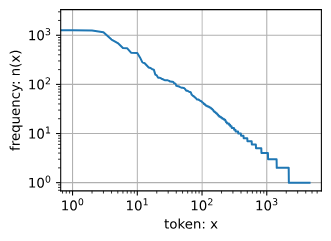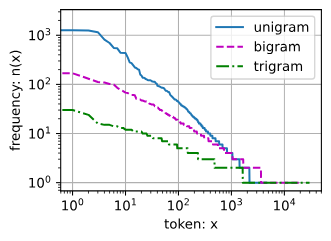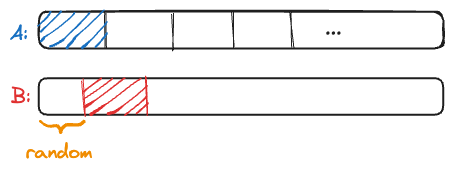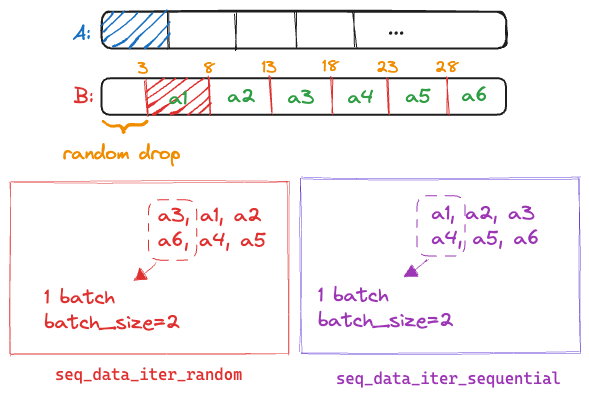8.3 语言模型和数据集
- 基于马尔科夫假设,介绍了 N-gram 模型
- 介绍了基于文本生成特征的的
SeqDataLoader类:- 随机生成:批和批之间不是连续的,完全独立的
- 顺序生成:批和批之间是连续的(一个批内的样本不一定连续)
1. N-gram 模型介绍
- 给定文本序列
, 语言模型的目标是估计联合概率 - 它的应用包括
- 做预训练模型 (eg BERT, GPT-3)
- 生成本文, 给定前面几个词, 不断的使用
来生成后续文本 - 判断多个序列中哪个更常见, e.g. “to recognize speech” vs "to wreck a nice beach
由条件概率公式:
这里
这个概率随着长度增加越来越不好算,假设后面生成的词只和当前词的前几个词有关(类似于卷积的局部性 6.2 图像卷积#^df8b77), 和序列模型一样(8.1 序列模型),取决于具体和前几个词有关:
一元语法(词和词之间是独立的):
二元语法(当前词与前一个词有关):
三元语法 (当前词与前两个词有关):
所以 N-gram 语言模型可以找到任意序列的概率,从而生成文本
- 不管 n 是几,都要计算 4 次来计算
的值 - 二元语法要知道任意两个词出现的概率,随着
的增加, 的个数呈指数上升
2. 时间与空间复杂度
时间复杂度 :
实际上,对于
这里把
空间复杂度
因为随着模型阶数增加,例如我语料中有 10 个词,二元词组就有 100 个,
3. 文本词频分布
时光机器数据集构建词表,并打印前10个最常用的(频率最高的)单词与频率分布
import random
import torch
from d2l import torch as d2l
tokens = d2l.tokenize(d2l.read_time_machine())
# 因为每个文本行不一定是一个句子或一个段落,因此我们把所有文本行拼接到一起
corpus = [token for line in tokens for token in line]
vocab = d2l.Vocab(corpus)
vocab.token_freqs[:10]
[('the', 2261),
('i', 1267),
('and', 1245),
('of', 1155),
('a', 816),
('to', 695),
('was', 552),
('in', 541),
('that', 443),
('my', 440)]
大部分都是没有实际意义的词,叫做停用词(stop words),继续在双对数坐标下画出频率分布:
freqs = [freq for token, freq in vocab.token_freqs]
d2l.plot(freqs, xlabel='token: x', ylabel='frequency: n(x)',
xscale='log', yscale='log')

对多元词组也计算一下分布:
bigram_tokens = [pair for pair in zip(corpus[:-1], corpus[1:])]
bigram_vocab = d2l.Vocab(bigram_tokens)
bigram_vocab.token_freqs[:10]
[(('of', 'the'), 309),
(('in', 'the'), 169),
(('i', 'had'), 130),
(('i', 'was'), 112),
(('and', 'the'), 109),
(('the', 'time'), 102),
(('it', 'was'), 99),
(('to', 'the'), 85),
(('as', 'i'), 78),
(('of', 'a'), 73)]
trigram_tokens = [triple for triple in zip(
corpus[:-2], corpus[1:-1], corpus[2:])]
trigram_vocab = d2l.Vocab(trigram_tokens)
trigram_vocab.token_freqs[:10]
[(('the', 'time', 'traveller'), 59),
(('the', 'time', 'machine'), 30),
(('the', 'medical', 'man'), 24),
(('it', 'seemed', 'to'), 16),
(('it', 'was', 'a'), 15),
(('here', 'and', 'there'), 15),
(('seemed', 'to', 'me'), 14),
(('i', 'did', 'not'), 14),
(('i', 'saw', 'the'), 13),
(('i', 'began', 'to'), 13)]
三元词组停用词更少一点,我们直观地对比三种模型中的词元频率:一元语法、二元语法和三元语法。
bigram_freqs = [freq for token, freq in bigram_vocab.token_freqs]
trigram_freqs = [freq for token, freq in trigram_vocab.token_freqs]
d2l.plot([freqs, bigram_freqs, trigram_freqs], xlabel='token: x',
ylabel='frequency: n(x)', xscale='log', yscale='log',
legend=['unigram', 'bigram', 'trigram'])

由于幂律分布,极少数词就包含了文本绝大多数词汇,所以 n 元语法空间复杂度并不会出现指数上升,这也是有些文章做到 7 元语法的原因
4. 读取文本序列数据
类似于序列模型,我们想从文本中构建特征,由于马尔科夫假设,我们可以固定窗口大小,如果滑动窗口步长为 1 去抽取特征。这样成本太高,如果我们头开始不相交的抽取文本,有些序列又覆盖不了:

所以,为了保证尽量覆盖所有序列,尽量避免重复使用序列,我们随机把前面部分删去一点,开始不相交的抽取特征,抽取有两种方法,随机和顺序:

- 随机采样每个批次的样本之前是独立的
- 顺序采样每个批之间是连续的
- 一共可抽取
,下面代码第六行,为什么这里要 ,是因为留一位抽取 y,例如[0,1,2,3] 抽取 num_steps=2 的序列只能抽 1 个,因为抽 [2,3] 就没有对应的 y 了
4.1 随机采样
def seq_data_iter_random(corpus, batch_size, num_steps): #@save
"""使用随机抽样生成一个小批量子序列"""
# 从随机偏移量开始对序列进行分区,随机范围包括num_steps-1
corpus = corpus[random.randint(0, num_steps - 1):]
# 减去1,是因为我们需要考虑标签
num_subseqs = (len(corpus) - 1) // num_steps
# 长度为num_steps的子序列的起始索引
initial_indices = list(range(0, num_subseqs * num_steps, num_steps))
# 在随机抽样的迭代过程中,
# 来自两个相邻的、随机的、小批量中的子序列不一定在原始序列上相邻
random.shuffle(initial_indices)
def data(pos):
# 返回从pos位置开始的长度为num_steps的序列
return corpus[pos: pos + num_steps]
num_batches = num_subseqs // batch_size
for i in range(0, batch_size * num_batches, batch_size):
# 在这里,initial_indices包含子序列的随机起始索引
initial_indices_per_batch = initial_indices[i: i + batch_size]
X = [data(j) for j in initial_indices_per_batch]
Y = [data(j + 1) for j in initial_indices_per_batch]
yield torch.tensor(X), torch.tensor(Y)
num_steps序列 X 的特征个数batch_size:一个批中包含的样本数
my_seq = list(range(35))
for X, Y in seq_data_iter_random(my_seq, batch_size=2, num_steps=5):
print('X: ', X, '\nY:', Y)
my_seq = list(range(35))
for X, Y in seq_data_iter_random(my_seq, batch_size=2, num_steps=5):
print('X: ', X, '\nY:', Y)
X: tensor([[13, 14, 15, 16, 17],
[28, 29, 30, 31, 32]])
Y: tensor([[14, 15, 16, 17, 18],
[29, 30, 31, 32, 33]])
X: tensor([[ 3, 4, 5, 6, 7],
[18, 19, 20, 21, 22]])
Y: tensor([[ 4, 5, 6, 7, 8],
[19, 20, 21, 22, 23]])
X: tensor([[ 8, 9, 10, 11, 12],
[23, 24, 25, 26, 27]])
Y: tensor([[ 9, 10, 11, 12, 13],
[24, 25, 26, 27, 28]])
这里的 Y 不是向量,而是 X 往后移一位的矩阵
4.2 顺序采样
def seq_data_iter_sequential(corpus, batch_size, num_steps): #@save
"""使用顺序分区生成一个小批量子序列"""
# 从随机偏移量开始划分序列
offset = random.randint(0, num_steps)
num_tokens = ((len(corpus) - offset - 1) // batch_size) * batch_size
Xs = torch.tensor(corpus[offset: offset + num_tokens])
Ys = torch.tensor(corpus[offset + 1: offset + 1 + num_tokens])
Xs, Ys = Xs.reshape(batch_size, -1), Ys.reshape(batch_size, -1)
num_batches = Xs.shape[1] // num_steps
for i in range(0, num_steps * num_batches, num_steps):
X = Xs[:, i: i + num_steps]
Y = Ys[:, i: i + num_steps]
yield X, Y
for X, Y in seq_data_iter_sequential(my_seq, batch_size=2, num_steps=5):
print('X: ', X, '\nY:', Y)
X: tensor([[ 3, 4, 5, 6, 7],
[18, 19, 20, 21, 22]])
Y: tensor([[ 4, 5, 6, 7, 8],
[19, 20, 21, 22, 23]])
X: tensor([[ 8, 9, 10, 11, 12],
[23, 24, 25, 26, 27]])
Y: tensor([[ 9, 10, 11, 12, 13],
[24, 25, 26, 27, 28]])
X: tensor([[13, 14, 15, 16, 17],
[28, 29, 30, 31, 32]])
Y: tensor([[14, 15, 16, 17, 18],
[29, 30, 31, 32, 33]])
4.3 整合成 SeqDataLoader 类
类似于 DataLoader 类 Pytorch 用法#^a5f724,封装成一个可迭代对象(Python 中的可迭代对象、迭代器#^89a039)
class SeqDataLoader: #@save
"""加载序列数据的迭代器"""
def __init__(self, batch_size, num_steps, use_random_iter, max_tokens):
if use_random_iter:
self.data_iter_fn = d2l.seq_data_iter_random
else:
self.data_iter_fn = d2l.seq_data_iter_sequential
self.corpus, self.vocab = d2l.load_corpus_time_machine(max_tokens)
self.batch_size, self.num_steps = batch_size, num_steps
def __iter__(self):
return self.data_iter_fn(self.corpus, self.batch_size, self.num_steps)
这里的 max_tokens 是防止序列过大做一个限制,整合在一起可以读取序列数据:
def load_data_time_machine(batch_size, num_steps, #@save
use_random_iter=False, max_tokens=10000):
"""返回时光机器数据集的迭代器和词表"""
data_iter = SeqDataLoader(
batch_size, num_steps, use_random_iter, max_tokens)
return data_iter, data_iter.vocab